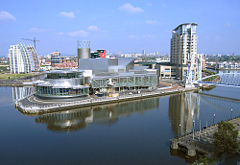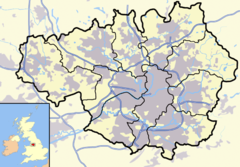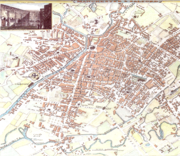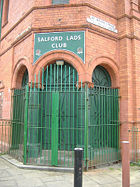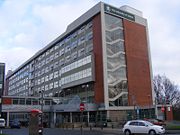Salford
2008/9 Schools Wikipedia Selection. Related subjects: British Cities; Great Britain
| Salford | |
|
Salford shown within Greater Manchester |
|
| Area | 8.1 sq mi (21 km²) |
|---|---|
| Population | 72,750 ( 2001 Census) |
| - Density | 8,981 /sq mi (3,468 /km²) |
| OS grid reference | |
| - London | 164 mi (264 km) SE |
| Metropolitan borough | Salford |
| Metropolitan county | Greater Manchester |
| Region | North West |
| Constituent country | England |
| Sovereign state | United Kingdom |
| Post town | SALFORD |
| Postcode district | M3, M5–M7 |
| Dialling code | 0161 |
| Police | Greater Manchester |
| Fire | Greater Manchester |
| Ambulance | North West |
| European Parliament | North West England |
| UK Parliament | Salford |
| Salford and Eccles | |
| List of places: UK • England • Greater Manchester | |
Coordinates:
Salford is a city in Greater Manchester, England. It lies in a meander of the River Irwell, which forms its boundary with the city of Manchester to the east. Together with neighbouring towns to the west, Salford forms the metropolitan borough of the City of Salford, which is administered from nearby Swinton. It was granted City status in 1926 and has a total resident population of 72,750 and an area of 8.1 square miles (21.0 km²). The wider City of Salford district has a population of 218,000.
Historically a part of Lancashire, Salford's early history is marked by its status as the judicial seat of the ancient hundred of Salfordshire, to which it lends its name. It was granted a charter by Ranulf, 4th Earl of Chester, about 1230 which made Salford a free borough. During the early stages of its growth, Salford was of greater cultural and commercial importance than its neighbour Manchester, although most contemporary sources agree that since the Industrial Revolution this position has been reversed.
Salford became a major factory town and inland port during the 18th and 19th centuries. Cotton and silk spinning and weaving in local mills provided Salford with a strong economy. Salford Quays was a principal dockyard of the Manchester Ship Canal. Industrial activities declined during the 20th century however, causing a local economic depression. The city subsequently became one of contrasts, with regenerated inner-city areas like Salford Quays next to some of the most socially deprived and violent areas in England.
Salford Cathedral is the centre of the Roman Catholic Diocese of Salford and the city today is a centre of higher education, being the location of the University of Salford. Salford is the home of the world's first free public library, and was the birthplace of the modern vegetarian movement. It also has the first street in the world to be lit by gas, Chapel Street in 1806. Salford is set to become the headquarters of CBBC and BBC Sport in 2011.
History
Toponymy
The name of Salford derives from the Anglo-Saxon Sealhford = "sallow-tree ford", in reference to the sallows or willow (Latin salix) trees that grow alongside the banks of the River Irwell. The ford was about where Victoria Bridge is today. Willow trees are still found in Lower Broughton. Salford appears in the Pipe Roll of 1169 as "Sauford" and in the Lancashire Inquisitions of 1226 as "Sainford".
Early history
The earliest known evidence of a human presence in what is now Salford is attested by the discovery of Neolithic flint arrow-heads and workings found on Kersal Moor and by the River Irwell, implying habitation 7–10,000 years ago. Evidence of later Bronze Age and Celtic activity is confirmed by an ancient archaeological relics found during the excavation of the Manchester Ship Canal and in the grounds of the Old Broughton Hall. The Salford area is likely to have been chosen for habitation due to its fertile land and ready supply of water and fish from the Irwell.
The Brigantes were the major Celtic tribe of what is now Northern England whom had a stronghold in the locality at a sandstone outcrop on which Manchester Cathedral now stands, opposite Salford's original centre. Their territory extended across the fertile lowland of what is now Salford and Stretford. Following the Roman conquest of Britain in the 1st century, General Agricola ordered the construction of a Roman fort in the year 79 named Mamucium to ensure Roman interests with Deva Victrix ( Chester) and Eboracum (York) were protected from the Brigantes.
According to the Anglo-Saxon Chronicle of 919, Salford during the Heptarchy had been part of the Kingdom of Northumbria, until conquered by Edward the Elder, King of the West Saxons. The Manor (or Hundred) of Salford comprised all the lands between the rivers Ribble and Mersey, contained nine large parishes, and came under the Diocese of Lichfield in matters ecclesiastical.
After the Norman Conquest, William I had granted Salford to Roger the Poitevin. In the Domesday Book of 1086 the Manor of Salford was recorded as covering an area of 350 square miles (906 km²) with a population of 35,000. Roger de Poitou created the subordinate Manor (or Parish) of Manchester which has ever since been separate in matters of local government from Salford. Poitou forfeited the manor when in 1102 he was defeated in a failed rebellion attempt against William's son, Henry I. Salford then passed into the hands of the 2nd Earl of Chester, Ranulph Gernons.
In 1228, the town of Salford received from King Henry III the right to hold a market and an annual fair. During the years of 1230 - 1232, Ranulf de Blundeville, Earl of Chester, granted the charter by which the town became a free borough, a charter by which Salford was governed until the Manchester and Salford Police Act 1791. There are references in official records to the Manor of Salford being one of the possessions of the Duchy of Lancaster. Since Henry IV's accession in 1399, the Duchy has been held by The Crown, and the Sovereign has thereby always been the Lord of the Manor of Salford.
Notes about Salford through the Tudor period and beyond are to be gleaned from the surviving volumes of the Portmote Records. The most famous family was the Radclyffes of Ordsall Hall and their exploits feature frequently in local history of the period. Humphrey Booth, a scion of the Dunham Massey family, founded Trinity Church in 1635 and his descendants, the Gore-Booths, are still patrons of the living.
In the English Civil War between King Charles I and parliament, Salford was Royalist, and the unsuccessful siege of Manchester, which was Parliamentarian, was conducted from its side of the River Irwell. A century later Salford was also noted as Jacobite territory; its inhabitants supported Charles Edward Stuart to the Throne of England. In November of the Second Jacobite Rebellion, Salford hosted Stuart on his ride through the area.
The first horse-drawn bus service ran between Pendleton and Manchester in 1824, and some of the world's first municipal parks are in Salford.
Industrial Revolution
Salford has a history of textile processing that pre-dates the Industrial Revolution. It had a cloth hall at Greengate and a considerable trade in the production and finishing of woollen goods and fustians before the dominance of cotton. There were other cottage industries, including clogging, cobbling, weaving and brewing during this time. It was textile manufacture during the Industrial Revolution that had a profound effect on the population, urbanisation as well as socioeconomic and cultural conditions of Salford however.
It was the River Irwell and its tributaries that attracted the entrepreneurs to establish cotton mills during the first phase of the Industrial Revolution. The first mills were constructed at Pendleton and Ordsall along the river banks. One of the first factories was the Salford Twist Mill. Although Salford followed a simillar pattern of industrial development to Manchester, most firms preferred to locate their warehouses and offices on the Manchester side of the Irwell. Subsequently, Salford did not evolve as a commercial centre in the same way.
Canal building gave a further stimulus to Salford's industrial development. The Bridgewater Canal increased supply of fuel and raw cotton, whilst the Manchester, Bolton and Bury Canal (which terminated at Salford) brought coal from pits at Pendleton and Agecroft Colliery. By 1818 Manchester, Salford and Eccles was noted to have had 80 mills, but it was the Manchester Ship Canal, a major ocean-going waterway completed in 1894, that facilitated Salford's development as a major inland port. Salford Docks brought employment for almost eighty years. From these docks, locally-produced goods were shipped all over the world.
Suggested that because of increased competition from the nearby towns of Bolton and Oldham, Salford did not endure as a centre for cotton spinning, as so its businessmen turned increasingly to other textiles and the finishing trades. Specialised rexine and silk dyeing, fulling and bleaching were carried out at a string of works in Salford. Textiles was the overwhelming sector of employment in Salford for centuries, whilst its other industries were almost always textile related.
In 1806, Chapel Street in Salford became the first street in the world to be lit by gas, which was supplied by Phillips and Lee's cotton mill. Karl Marx and Friedrich Engels spent some time in Salford, analysing the plight of the British working class, particularly in The Condition of the Working Class in England in 1844. In 1849 the municipal borough council was the first in England to establish a public library, museum and art gallery, preceding the Public Libraries Act of 1850.
The effect of the 19th-century Industrial Revolution on Salford has been described as "phenomenal". Salford expanded from a small market town into a major industrial metropolis; factories replaced homeworking, and the population, 12,000 in 1812, rose in 30 years to 70,244. By the end of the 19th century it stood at 220,000. The rapid increase to overpopulation, hardly exceeded anywhere in the country, was reflected in the vast areas of poor quality squalid terraced housing that were built throughout the Victorian era when overcrowding lead to chronic social deprivation. Houses were crowded together at as many as 80 to the acre.
Decline
At the start of the 20th century, changes in regional transport infrastructre, including new major inter-urban roads, began to supplant Salford's old industries, including those activities performed at the Salford Docks. Increased competition from outside of the UK began to undermine the competitiveness of local textile processing businesses. In the decades following the Second World War there was a significant economic and population decline in Salford. Thousands were unemployed during the Great Depression. By 1939 coal mining had finished and cotton spinning had ceased by 1971. Each of the post war decades witnessed population decline in Salford of over 10%, far greater than the rate of decline within North West England as a whole. People have followed employment opportunities to other locations in Greater Manchester, taking advantage of a greater choice in the type and location of housing. It is only since the early 1990s that this decline has slowed.
A survey in 1931 concluded that parts of Salford were amongst the worst slums in the country. Many of its houses were infested by rats and lacked elementary amenities. Inspectors found that of 950 houses surveyed, 257 were in a state of bad repair with leaking roofs, broken flooring and rotten woodwork, though were "struck by the courage and preseverance with which the greater number of tenants kept their houses clean and respectable under most adverse conditions".
Vast areas of the city were re-developed in the 1960s and 1970s, with Victorian era terraced housing giving way to concrete tower blocks and austere architecture. Salford Docks declined during the same period.
In early 2005, Riga appealed to the European Union to advise people against travelling to Salford after a Latvian man was stabbed in the head in Lower Broughton. However, city councillors have insisted that Salford is a safe place to visit. In August 2005, a survey by Channel 4 television rated the city as the 9th worst place to live in the UK (based on criteria of crime, education, environment, lifestyle and employment).
Regeneration
Salford has had high-levels of unemployment, housing and social problems since around the 1960s, though there are regeneration schemes to reverse its fortunes. The many high-rise blocks that remain are a striking feature of the city. Work was scheduled to begin on the £180 million redevelopment of the Greengate area of Salford in January 2007. The plans include the construction of what will be the two tallest tower blocks in Salford. Plans also include a five-star hotel, a new public square and park, restaurants, cafes and 403 apartments. Work is ongoing to regenerate the area known as Middlewood Locks, with the restored Salford end of the Manchester, Bolton and Bury Canal forming the centrepiece of a brand new residential development.
Salford now has many tourist attractions, such as Ordsall Hall, the Bridgewater Canal and the Lowry Centre, an award winning art gallery comprising two theatres and three art galleries. The centre is named after the artist L. S. Lowry, who attended Salford School of Art and lived in Pendlebury for 40 years. Many of his paintings of Salford and Manchester mill scenes, populated with small matchstick-like figures, are on display there.
Governance
Salford is represented by three tiers of government, Salford City Council ("local"), UK Parliament ("national"), and European Parliament ("Europe"). Greater Manchester County Council administration was abolished in 1986, and so the city council is effectively a unitary authority.
Salford was anciently part of the Manchester parish of the Salford Hundred, an area much larger than the present-day city of Salford, within the historic county boundaries of Lancashire. A stroke of a Norman baron's pen is said to have divorced Manchester and Salford, though it was not Salford that became separated from Manchester, it was Manchester, with its humbler line of lords, that was separated from Salford. Salford received its town charter from Ranulph de Blondeville, 4th Earl of Chester, then Lord of the Manor, in 1230. It was not recognised as a borough in the Municipal Corporations Act 1835, but was granted borough status in 1844; the new Salford borough was made up of the township of Salford and part of Broughton. The remainder of Broughton, and a part of Pendlebury, were added in 1853. In 1841, Salford was partly governed by a reeve and two constables, appointed at the hundred courts leet; mention occurs of the boroughreeve in a charter granted to the burgesses in 1231, by the Earl of Chester. These officers, conjointly with certain inhabitants, were empowered by an act passed 1792, to govern and regulate the town; this act, as amended 1830, authorised the reeve, constables, and 120 persons elected by the rate-payers in eight police districts, to govern Salford with the purpose of civic improvement.
When the administrative county of Lancashire was created by the Local Government Act 1888, Salford was elevated to become the County Borough of Salford and was effectively a unitary authority area exempt from the administration of Lancashire County Council. The County Borough of Salford was granted city status in the United Kingdom in 1926, and in 1961 a small part of Eccles was added to the city. In 1974 the City and County Borough of Salford was abolished under the Local Government Act 1972, and was replaced by the metropolitan borough of City of Salford, a local government district of the new metropolitan county of Greater Manchester, with triple the territory of the former City of Salford. Both Salford and the City of Salford are unparished areas.
Salford was twinned with Clermont-Ferrand in France in 1966. The wider City of Salford district has formal twinning arrangements with three other towns.
Parliamentary representation
Salford was enfranchised as a parliamentary borough by the Great Reform Act of 1832.
Salford lies within the Salford parliamentary constituency, having done so since its creation in 1997. Hazel Blears – a member of the Labour Party – has been the Member of Parliament for the constituency since 1997.
Geography
At (53.483, -2.2931), and 205 miles (330 km) northwest of London, Salford stands around 160 feet (49 m) above sea level, on relatively flat ground to the west of a meander of the River Irwell – the city's main topographical feature. In 1904 Salford was recorded as "within a great loop of the River Irwell ... roughly three quarters of a mile from north to south and one mile from east to west". Salford is contiguous with Manchester, and has been described "in participation of its trade, and for all other practical purposes, an integral part of it; presents a near resemblance to it in streets and edifices; contains several public buildings and a great public park, which belong fully more to Manchester than to itself". Greengate, the original centre of Salford, is located at a fording point on the river opposite Manchester Cathedral. In 1969 Nikolaus Pevsner wrote:
That [neighbouring] Stretford and Salford are not administratively one with Manchester is one of the most curious anomalies of England.
—Nikolaus Pevsner, Lancashire, The Industrial and Commercial South, 1969
| Climate chart for Salford | |||||||||||
|---|---|---|---|---|---|---|---|---|---|---|---|
| J | F | M | A | M | J | J | A | S | O | N | D |
|
70
6
1
|
50
7
1
|
60
9
3
|
50
12
4
|
60
15
7
|
70
18
10
|
70
20
12
|
80
20
12
|
70
17
10
|
80
14
8
|
80
9
4
|
80
7
2
|
| temperatures in °C precipitation totals in mm source: " Records and averages". Yahoo! Weather (2008). |
|||||||||||
|
Imperial conversion
|
|||||||||||
The Irwell, sourced at Cliviger in Lancashire, flows from the north and forms the statutory boundary with the City of Manchester to the east. Flooding has historically been a problem and the Irwell has seen much modification along its course in Salford with some bends being removed, channelisation, and the construction of levees and bank reinforcements. Salford has expanded along the river valley to the north and south and on to higher ground on the valley sides at Irlams o' th' Height and Higher Broughton.
Salford's built environment comprises a range of building stock. Some inner-city areas are noted for chronic urban decay. Salford's housing stock is characterised by an oversupply of older, smaller terraced housing, and flatted accommodation that declined in value during the late-20th century. As demand fell, it left many owners in negative equity and often without a means to maintain their homes in reasonable condition. Subsequently much of the built environment is poor.
The land use in Salford is overwhelmingly urban, with few areas of green space or rural space; the largest open space is Peel Park, close to the University of Salford. The territory of Salford is contiguous with other towns on all sides, and for purposes of the Office for National Statistics, forms the sixth largest settlement of the Greater Manchester Urban Area, the United Kingdom's third largest conurbation. The M602 motorway enters Salford from Eccles to the west. The A580 "East Lancs" road terminates at Salford, entering the area from Swinton. Heavy rail lines pass through Salford.
Salford has no central business district. Kersal is the location of Salford's highest point above sea level.
|
|||||
Demography
It is a city of contrasting demographies. Whilst the area immediately adjacent to Manchester city centre and Salford Quays are affluent, other parts of the city are some of the most deprived communities in the United Kingdom.
Salford has not, in general, attracted the same ethnic and cosmopolitan communities as in other parts of Greater Manchester. Salford did attract significant numbers of Irish people in the mid-19th century however. Many migrated to Salford because of The Great Hunger in Ireland combined with Salford's reputation as a hub for employment in its factories and docks. In 1848, Salford Roman Catholic Cathedral was consecrated, reflecting Salford's large Irish-born community it had at the time.
In the decades following the Second World War there was a significant population decline. There were slum renewal projects in central Salford during the 1960s and 70s, dispersing much of the population out of the city.
| Year | 1901 | 1911 | 1921 | 1931 | 1939 | 1951 | 1961 | 1971 | 2001 |
|---|---|---|---|---|---|---|---|---|---|
| Population | 162,452 | 172,998 | 234,045 | 223,438 | 166,386 | 178,194 | 155,090 | 131,006 | 72,750 |
| Sources: A Vision of Britain through Time |
|||||||||
Economy
For decades Salford's economy was heavily dependent on manufacturing industry, especially textiles and engineering. Since World War II however, Salford has experienced decades of growing unemployment as these sectors diminished and new sectors chose to locate in out of town locations with better transport links. Between 1965 and 1991 the City lost over 49,000 jobs, or more than 32% of its employment base. Several factors contributed to this decline, not least changes in the national and international economies, the introduction of new technology and the concentration of investment in London and South East England. The biggest job losses were experienced in the City's traditional industries and although the service sector expended during this period, it was unable to compensate for the decline in manufacturing.
The inner city's main shopping area is Salford Shopping City, Pendleton – colloquially referred to as 'the Precinct' – close to the University of Salford. However this area suffers from extreme deprivation and is dominated by the central business district of nearby Manchester. This is planned to change in the next few years with the implementation of the Pendleton Area Action Plan and the development of the pedestrianised and boulevarded A6 Corridor. Salford Quays has been shortlisted as the new possible city centre by 2020.
The city has seen a rise in major construction projects especially at Salford Quays and along the banks of the River Irwell that are shared with Manchester City Centre. Residential and office tower blocks have been common.
Salford has regional offices and headquarters for the major corporations of IBM, McDonald's, BUPA and Citifinancial.
Salford is credited as the birthplace of the Bush Roller Chain. Hans Renold, a Swiss-born engineer, came to Salford in the late 19th century. In 1879 he purchased a small textile-chain making business in Ordsall from James Slater and founded the Hans Renold Company, what is now Renold, a firm which still produces chains. Renold invented the bush roller chain shortly after and began producing it. It is the type of chain most commonly used for transmission of mechanical power on bicycles, motorcycles, to industrial and agricultural machinery to uses as varied as rollercoasters and escalators.
Landmarks
Salford Cathedral is one of the larger Catholic cathedrals in northern England. It was built between 1844 and 1848, and was listed as a Grade II* building in 1980.
Salford Lads Club is a recreational club established in 1903 and located in Ordsall. It is a listed building and gained international fame in 1986 when the pop band The Smiths posed in front of it for the inside cover of their album The Queen Is Dead. A report by English Heritage said "The building is thought to be the most complete example of this rare form of social provision to survive in England." In 2007, the Manchester Evening News reported that the club was third in a nationwide hunt to find the most iconic buildings in the country.
Ordsall Hall is a historic house and a former stately home in Ordsall. It dates back over 800 years, although the oldest surviving parts of the hall were built in the 15th century. The hall has been put to many uses – a family home, working men's club and school for clergy amongst them – and was opened to the public in 1972, as a period house and local history museum. The hall is a Grade I listed building.
Transport
The city is linked to other parts of Greater Manchester by the Manchester Metrolink tram system, which runs near the docks area to Langworthy and Eccles.
There are mainline railway stations at Salford Central and Salford Crescent.
In 1824, John Greenwood started the first bus operation from Pendleton to Market Street Manchester.
Education
On 2 November 1956 the Royal Technical College, Salford, was granted the status of a College of Advanced Technology (CAT). Colleges which transferred to CATs were required to drop lower-level courses and concentrate on both full-time and part-time university-level courses.
In November 1963 the Robbins Report recommended that the CATs should become technological universitites; and on 4 April 1967 a Charter was established creating the University of Salford. It is one of four universities in Greater Manchester and has approximately 19,000 students.
Salford also has numerous colleges. These include Pendleton College , which in September 2007 added a state of the art £10 million building, with media recording studios, LRC and 280-seat "Eccleston" theatre, named after the Salford actor Christopher Eccleston; Eccles College; and Salford College, which has two main campuses, Worsley Campus and City Campus located in Salford.
Culture
Salford Museum and Art Gallery opened in November 1850 as the Royal Museum and Public Library. It was built on the site of Lark Hill estate and Mansion, which was purchased by public subscription. The park was named Peel Park after Robert Peel who contributed to the subscription fund. The Library is notable because it was the first unconditionally free public library in the country.
Salford's first annual film festival, held at the Red Cinema in the Lowry Outlet at Salford Quays in 2003, was a huge success. The second, in November 2004 achieved similar results, showcasing some new local talent. Manchester's award-winning international theatre festival 27/4, takes place each July at the North of England's only fringe theatre venue, Studio Salford at the King's Arms, Bloom Street, Salford, which is also a popular live music venue.
Due to its cheap rent and plentiful supply of redundant mill buildings, Salford is host to a number of artists, including those based at Cow Lane Studios, Kings Arms, Islington Mill and Suite Studio Group. Salford's visual art scene, completely homogeneous with that of Manchester includes publicly owned galleries at The Lowry, Salford City Museum as well as independent spaces such as Bureau. The Salford Symphony Orchestra is an amateur orchestra originally founded in 1947 by Joseph Needham. It was disbanded in 1985, but re-formed in 1995. Mediacity is in the process of construction on the Quays near the Lowry and will house several relocated national departments of the BBC
Salford also boasts the birthplace of numerous bands, including Joy Division.
Public services
Since 1974, Home Office policing in Salford has been provided by the Greater Manchester Police. The force's "(F) Division" has its headquarters for policing the City of Salford at Pendleton and Salford Quays. Prior to this Salford was policed by the Manchester and Salford Police. Public transport is co-ordinated by the Greater Manchester Passenger Transport Executive. Statutory emergency fire and rescue service is provided by the Greater Manchester Fire and Rescue Service, whose headquarters are at nearby Swinton.
Salford Royal, at Claremont near the boundary with Eccles, is a large NHS hospital administrated by Salford Royal NHS Foundation Trust. The North West Ambulance Service provides emergency patient transport. Other forms of health care are provided for locally by several small clinics and surgeries.
Waste management is co-ordinated by the local authority via the Greater Manchester Waste Disposal Authority. Salford's Distribution Network Operator for electricity is United Utilities; there are no power stations in the city. United Utilities also manages Salford's drinking and waste water.
